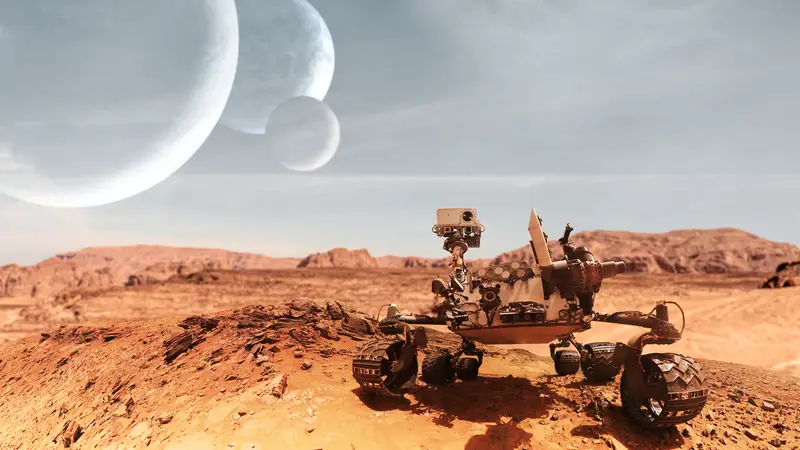Remember when you were a kid and your imagination ran wild with dreams of space travel? Maybe you pictured yourself bouncing across the red Martian surface in a cool spacesuit. For decades, movies and books have painted Mars as humanity’s next big adventure. NASA has talked about it. Billionaires have promised it. Yet here we are in 2025, and no human has even come close to setting foot on Mars. What’s the holdup? Despite all our amazing technology and space know-how, there’s one brutal obstacle that keeps getting in our way – and it might be impossible to overcome.
Space radiation poses a deadly threat to astronauts
Right now, as you read this, you’re protected by Earth’s magnetic field and atmosphere. They work like a shield, blocking most of the harmful radiation that constantly bombards our planet from space. But astronauts traveling to Mars would face this danger head-on with no natural protection. This isn’t just a minor inconvenience – it’s potentially deadly. The radiation comes from two main sources: solar flares from our sun and cosmic rays from deep space, which are even more energetic and harder to shield against.
The effects on the human body are scary. Radiation damages cells and DNA, increasing cancer risk dramatically. It can harm the nervous system, affecting how astronauts think and move. It can weaken the immune system, making space travelers more likely to get sick when they’re millions of miles from the nearest doctor. Scientists are working on better radiation shields, but the current technology just isn’t good enough to keep people safe during the minimum 1,000-day round trip to Mars.
The mind-bending distance creates communication nightmares
Think about how frustrating it is when your video call freezes for a few seconds. Now imagine trying to talk to someone with a delay of up to 20 minutes each way! That’s the reality of Mars communications. At its closest, Mars is still 34 million miles from Earth. At its farthest, it’s a whopping 250 million miles away. This means that if something goes wrong – a medical emergency, equipment failure, or any unexpected crisis – the astronauts would be completely on their own. There’s no quick call home for help, no rescue mission possible.
The psychology of dealing with such isolation is intense. Even with today’s technology, astronauts would essentially be cut off from Earth in a way no humans have ever experienced. Mission control couldn’t provide real-time guidance during critical moments. Worse still, there are periods called “solar conjunction” when the sun sits directly between Earth and Mars, blocking communications entirely for about two weeks. Imagine facing a life-threatening situation with no ability to contact Earth at all. This communication challenge alone makes a Mars mission incredibly risky.
Our rockets aren’t powerful enough yet
Getting to Mars isn’t just a matter of pointing a rocket and pressing “go.” The sheer amount of stuff needed for humans to survive the journey and stay on Mars is mind-boggling. We’re talking about food, water, air, medical supplies, scientific equipment, habitat materials, and enough fuel to get back home. Current rocket technology simply can’t carry all this in one trip. The mass requirements are enormous – much more than even SpaceX’s massive Starship can handle in a single launch.
Then there’s the landing problem. Mars has a tricky atmosphere – too thin to be really helpful for slowing down spacecraft (like Earth’s atmosphere does), but thick enough to cause problems. Landing a small rover like Perseverance was incredibly difficult. Now imagine landing something the size of a house, with people inside who can’t survive a crash. We need completely new systems for “atmospheric entry, descent, and landing” that can safely bring large, heavy spacecraft down to the Martian surface. Scientists are working on inflatable decelerators and supersonic retropropulsion, but these technologies aren’t ready for human missions yet.
Living off the Martian land is harder than it sounds
Movies make living on Mars look simple – just set up some greenhouses and you’re good to go. The reality is much harsher. Mars is cold (think Antarctica, but worse), has almost no atmosphere, and its soil contains toxic chemicals called perchlorates. There’s water ice, but extracting it requires energy and equipment. Making breathable oxygen, drinkable water, and growing food would all be major challenges requiring technologies we’re still developing. NASA’s MOXIE experiment on the Perseverance rover has produced tiny amounts of oxygen from the Martian atmosphere, but scaling this up for human needs is a whole different ballgame.
The concept is called “in-situ resource utilization” (ISRU) – using what’s available on Mars rather than bringing everything from Earth. It makes sense in theory, but the reality is extremely challenging. For example, producing rocket fuel for the return journey would require mining water ice, splitting it into hydrogen and oxygen, then combining the hydrogen with carbon from the atmosphere to make methane. Each step needs power, equipment, and time. If any part of this complex chain fails, astronauts could be stranded forever. The technology for reliable ISRU simply doesn’t exist yet, despite what optimistic timelines from space agencies might suggest.
The human body falls apart in space
Our bodies evolved over millions of years to thrive in Earth’s gravity, with its protective magnetic field and atmosphere. Take those away, and weird things start happening. In zero gravity during the journey to Mars, astronauts would lose bone density and muscle mass at alarming rates. Their vision can deteriorate due to fluid shifts in the body. Their immune systems weaken. Even with exercise equipment like resistance bands and specialized workouts, these effects are hard to counteract during long missions.
Once on Mars, the gravity is only about 38% of Earth’s. We simply don’t know how the human body would adapt to this over long periods. Would bones continue to weaken? Could humans reproduce safely? Would the heart and other organs function properly? Then there’s the return to Earth – after months or years in lower gravity, coming back to full Earth gravity could be physically devastating. Astronauts who spend just months on the International Space Station often can’t walk when they first return, and a Mars mission would be much longer. These physiological challenges remain largely unsolved, and some may be unsolvable without fundamental changes to human biology.
Mental health breaks down in extreme isolation
Being cooped up with the same few people for three years in a space the size of a small apartment would test anyone’s sanity. The psychological challenges of a Mars mission are enormous and often overlooked. Astronauts would face extreme isolation, confinement, and the constant stress of knowing that any mistake could be fatal. The communication delay with Earth would mean no real-time conversations with family and friends. Special occasions, birthdays, and holidays would pass with only delayed messages from loved ones.
NASA and other space agencies run isolation experiments like the HI-SEAS program in Hawaii, where volunteers live in Mars-like conditions to study these effects. The findings aren’t always encouraging. Even carefully selected, highly trained individuals experience conflicts, depression, and anxiety during these simulations – and these people know they can walk out the door if things get too bad. Real Mars astronauts wouldn’t have that option. They would need to maintain peak performance and mental health while facing dangers and isolation far beyond what any human has experienced. The psychological support systems for such a mission don’t yet exist.
The sheer cost makes Mars missions politically impossible
Space exploration isn’t cheap, and a Mars mission would be the most expensive human endeavor ever attempted. Estimates range from hundreds of billions to over a trillion dollars. That’s money that could build hospitals, fix roads, fund education, or address climate change. In a world with pressing problems here on Earth, it’s hard for politicians to justify spending that kind of money on sending a few people to another planet. NASA’s budget has remained relatively flat for decades, nowhere near what would be needed for a serious Mars program.
Even during the Apollo era, when the US was racing against the Soviet Union to reach the Moon, public support for the massive spending was never as high as people remember. Without the Cold War motivation of beating another superpower, sustaining political will for the decades needed to develop Mars technologies is extremely difficult. Administrations change every four or eight years, each with different priorities. Long-term projects like a Mars mission are vulnerable to budget cuts and changing directions with each new president. This lack of consistent funding and direction has repeatedly derailed Mars plans, with each new administration often scrapping the previous one’s approach.
Self-sufficiency in space remains a pipe dream
On the International Space Station, if something breaks, replacement parts can arrive in days. If an astronaut gets sick, they can return to Earth in hours. On Mars, they’d be on their own for years. Every system would need multiple backups. Every medical condition would need to be treatable with limited supplies. The level of self-sufficiency required is staggering and far beyond our current capabilities. Things we take for granted on Earth – fixing broken equipment, dealing with medical emergencies, even handling waste – become enormously complicated on Mars.
Life support systems would need to be nearly perfect, recycling air and water with minimal losses. Food production would need to be reliable even if equipment fails. Medical care would need to cover everything from dental emergencies to appendicitis with limited equipment and no specialist doctors. Astronauts would need to become experts in dozens of fields, able to repair anything that breaks using only the tools and parts they brought with them. This level of closed-loop living and complete self-sufficiency has never been achieved, even in test environments on Earth. The closest attempts, like the Biosphere 2 experiment in the 1990s, ran into numerous unforeseen problems that would be deadly on Mars.
Despite these incredible challenges, humans haven’t given up on the red planet. Scientists continue working on solutions for radiation shielding, better rockets, and life support systems. Maybe someday we’ll overcome these obstacles and set foot on Martian soil. But for now, the harsh reality is that Mars remains tantalizingly out of reach – not because we don’t want to go, but because the universe has placed a deadly barrier of radiation and distance between us and our planetary neighbor.

